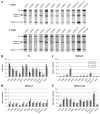Role of SFRS13A in low-density lipoprotein receptor splicing
- PMID: 20232416
- PMCID: PMC3184548
- DOI: 10.1002/humu.21244
Role of SFRS13A in low-density lipoprotein receptor splicing
Abstract
Low-density lipoprotein receptor (LDLR) is a major apolipoprotein E (APOE) receptor and thereby is critical to cholesterol homeostasis and, possibly, Alzheimer disease (AD) development. We previously identified a single nucleotide polymorphism (SNP), rs688:C>T, that modulates LDLR exon 12 splicing and is associated with cholesterol levels in premenopausal women and with Alzheimer disease in men. To gain additional insights into LDLR splicing regulation, we seek to identify splicing factors that modulate LDLR splicing efficiency. By using an in vitro minigene study, we first found that ectopic expression of SFRS3 (SRp20), SFRS13A (SRp38), SFRS13A-2 (SRp38-2), and RBMX (hnRNP G) robustly decreased LDLR splicing efficiency. Although SFRS3 and SFRS13A specifically increased the LDLR transcript lacking exon 11, SFRS13A-2 and RBMX primarily increased the LDLR isoform lacking both exons 11 and 12. When we evaluated the relationship between the expression of these splicing factors and LDLR splicing in human brain and liver specimens, we found that overall SFRS13A expression was significantly associated with LDLR splicing efficiency in vivo. We interpret these results as suggesting that SFRS13A regulates LDLR splicing efficiency and may therefore emerge as a modulator of cholesterol homeostasis.
Figures




Similar articles
-
Sex-dependent association of a common low-density lipoprotein receptor polymorphism with RNA splicing efficiency in the brain and Alzheimer's disease.Hum Mol Genet. 2008 Apr 1;17(7):929-35. doi: 10.1093/hmg/ddm365. Epub 2007 Dec 8. Hum Mol Genet. 2008. PMID: 18065781 Free PMC article.
-
Mutual effect of rs688 and rs5925 in regulating low-density lipoprotein receptor splicing.DNA Cell Biol. 2014 Dec;33(12):869-75. doi: 10.1089/dna.2014.2577. DNA Cell Biol. 2014. PMID: 25188588
-
A common polymorphism decreases low-density lipoprotein receptor exon 12 splicing efficiency and associates with increased cholesterol.Hum Mol Genet. 2007 Jul 15;16(14):1765-72. doi: 10.1093/hmg/ddm124. Epub 2007 May 21. Hum Mol Genet. 2007. PMID: 17517690 Free PMC article.
-
microRNA-185 modulates low density lipoprotein receptor expression as a key posttranscriptional regulator.Atherosclerosis. 2015 Dec;243(2):523-32. doi: 10.1016/j.atherosclerosis.2015.10.026. Epub 2015 Oct 23. Atherosclerosis. 2015. PMID: 26523989
-
Splicing regulation: the cell cycle connection.Curr Biol. 2003 Feb 18;13(4):R149-51. doi: 10.1016/s0960-9822(03)00079-4. Curr Biol. 2003. PMID: 12593819 Review.
Cited by
-
Inflammation and hyperglycemia mediate Deaf1 splicing in the pancreatic lymph nodes via distinct pathways during type 1 diabetes.Diabetes. 2015 Feb;64(2):604-17. doi: 10.2337/db14-0803. Epub 2014 Sep 3. Diabetes. 2015. PMID: 25187368 Free PMC article.
-
Dephosphorylated NSSR1 is induced by androgen in mouse epididymis and phosphorylated NSSR1 is increased during sperm maturation.PLoS One. 2011;6(9):e25667. doi: 10.1371/journal.pone.0025667. Epub 2011 Sep 29. PLoS One. 2011. PMID: 21980524 Free PMC article.
-
Medulla oblongata transcriptome changes during presymptomatic natural scrapie and their association with prion-related lesions.BMC Genomics. 2012 Aug 16;13:399. doi: 10.1186/1471-2164-13-399. BMC Genomics. 2012. PMID: 22897917 Free PMC article.
-
Western diet in ApoE-LDLR double-deficient mouse model of atherosclerosis leads to hepatic steatosis, fibrosis, and tumorigenesis.Lab Invest. 2014 Nov;94(11):1273-82. doi: 10.1038/labinvest.2014.112. Epub 2014 Sep 8. Lab Invest. 2014. PMID: 25199052
-
Identification of SRSF10 as a regulator of SMN2 ISS-N1.Hum Mutat. 2021 Mar;42(3):246-260. doi: 10.1002/humu.24149. Epub 2020 Dec 16. Hum Mutat. 2021. PMID: 33300159 Free PMC article.
References
-
- Ars E, Serra E, Garcia J, Kruyer H, Gaona A, Lazaro C, Estivill X. Mutations affecting mRNA splicing are the most common molecular defects in patients with neurofibromatosis type 1. Hum Mol Genet. 2000;9(2):237–47. - PubMed
-
- Caceres JF, Kornblihtt AR. Alternative splicing: multiple control mechanisms and involvement in human disease. Trends Genet. 2002;18(4):186–93. - PubMed
-
- Cao D, Fukuchi K, Wan H, Kim H, Li L. Lack of LDL receptor aggravates learning deficits and amyloid deposits in Alzheimer transgenic mice. Neurobiol Aging. 2006;27(11):1632–43. - PubMed
Publication types
MeSH terms
Substances
Grants and funding
LinkOut - more resources
Full Text Sources
Miscellaneous

